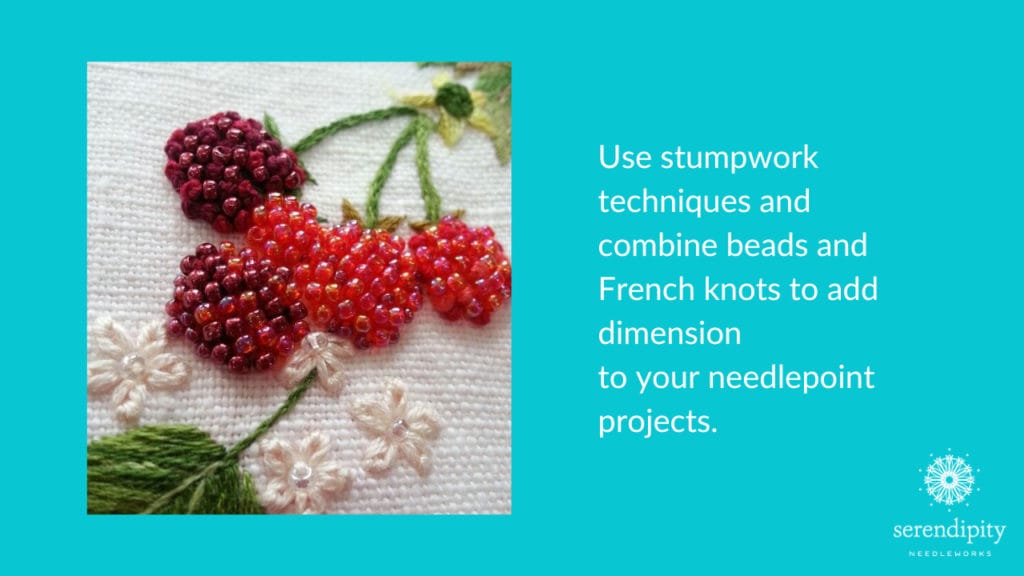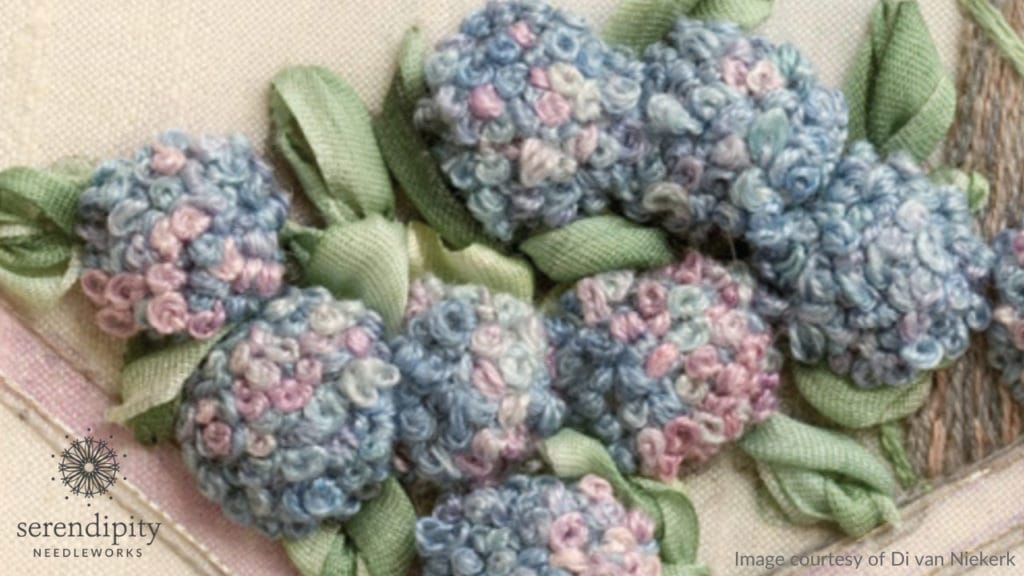So, you want to add some dimension to your needlepoint canvases? Well, my friend, stumpwork is one of the best ways to do just that!
Never heard of it? No worries… I’m going to tell you all about it. 😉
Stumpwork is an old form of embroidery that reached the height of its popularity in the late 17th century. Common themes for stumpwork embroideries included biblical stories and classical mythology.
Stumpwork has very few “rules” which means that it allows the needle artist to remain creative! (And I just love that, don’t you?!)
Traditionally, an embroiderer stitches stumpwork on ivory silk, satin-weave silk, or plain-weave linen. But since we’re needlepointers, I’ll share how we can use stumpwork techniques to form 3-dimensional effects on our canvases. Let’s dive in…
Threads
Let’s begin with a peek at the threads you might use in stumpwork:
- stranded cotton
- silk machine thread
- fine semi-transparent thread
- perlé cotton
- pure silk embroidery thread (stranded and non-divisible)
- flower thread
- silk cord
- silk ribbon
- metal thread
Needles
There are lots of different kinds of needles that you will need for stumpwork:
- embroidery/crewel needles
- chenille needles
- tapestry needles (we ought to have plenty of those… teehee!)
- beading needles
- sharps needles
Other Materials
Of course, there are other materials that you’ll use, too:
- wooden beads
- paper covered wire/stainless steel wire
- glass beads
- found objects (e.g., shells, bells, etc.)
- seed pearls
- fine, soft leather
- copic markers
- cotton string
- acid free paper card stock
- and more!
There are some flat surface embroidery stitches that you’ll want to brush up on:
- running stitch
- stem stitch/outline stitch
- back stitch
- couching
- straight stitch
- long and short stitch
- satin stitch
And there are some raised surface stitches that you will use in stumpwork, too:
- French knot
- bullion knot
- woven picot
- raised stem band
- buttonhole stitch
- Turkey tufting
- plus lots more!
One of the things that makes stumpwork dimensional is the extensive use of padding.
There are different ways to pad an area on your canvas. You may pad with stitches – or you may use felt padding. String padding is yet another form of padding. And wood shapes and beads may serve as a form of padding, too.
Slips are separate pieces of embroidery that are worked on another piece of fabric, then applied to your canvas.
The key to success with using slips on your projects is to keep the shapes simple. You may use wire to create sculptable slips. Wired slips are especially effective for flower petals, leaves, and insect wings.

Another stumpwork technique is wrapping…
You can wrap wooden beads with silk ribbon to create berries and small fruits. And you may wrap wire with thread to form flower stems, tree trunks, and even human hands to add dimension to your canvases.
Your imagination is really your only limitation when it comes to using stumpwork techniques to add dimension to your needlepoint projects.
I’m teaching an introduction to stumpwork class on Saturday, September 17.
It’s called Simple Stumpwork and we still have a few spaces available. The techniques we’ll cover are suitable for all skill levels and you can learn more about the workshop here.
Alrighty – that’s all for now, my friend. I hope you have a terrific rest of your day and, until next time, happy stitching!! 🙂
XOXO!!






I missed your September 17th class. Will you be doing another class on Intro to Stumpwork anytime in the future?
Thank you,
Mary Paddy
Hi Mary
I’m so sorry you missed the class. As a member of The Stitcher’s Club, you will have access to the recordings. We’re working on getting those posted in the Member Portal and will share when they’re ready in your Weekly Update email. 🙂
Thank you for being part of our Stitcher’s Club family.
XOXO!
Ellen